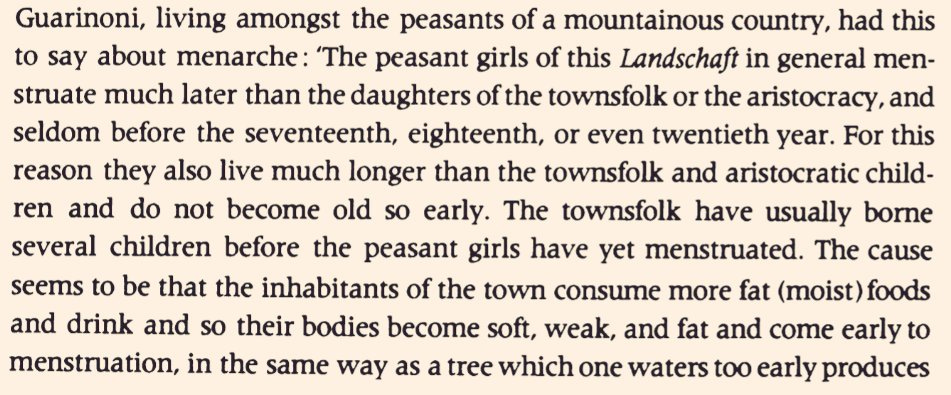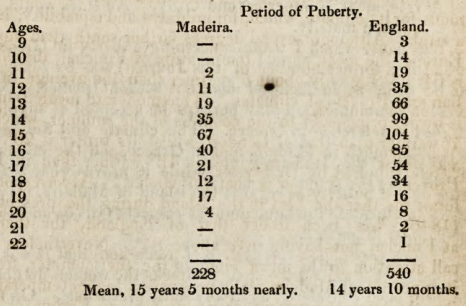The Decline of The Age of Menarche
"It must be remembered that in highly developed countries of the West at least, the mean age at menarche has been decreasing steadily for at least a century at a rate of 4 months per decade." - Tanner
The idea that the average core body temperature of people in the West has been steadily decreasing starting from the Industrial Revolution is slowly gaining traction in mainstream science, although the reason for why is usually incorrectly prescribed either out of ignorance or indoctrination. A lesser-explored topic that is tangentially related to the abovementioned trend is the declining age of menarche in girls, observed over the last century.
Between 1840 and 1970, the average age of menarche in Norway declined approximately from 17 to 13 years, in Finland from 16.5 to 13, and in Holland from 15.5 to 13. A similar decline can be seen in the United States, Sweden, and Denmark. A rather noteworthy remark that must be mentioned is Guarinoni’s observation of the peasant girls living in mountainous Switzerland/Austria, whose onset of menarche ranged from 17-20 years of age, and who lived longer and healthier lives compared to the townspeople. The latter bore several children before the peasant girls had even menstruated. (1610)
A relatively modest sample from England and Madeira from the middle of the 19th century shows considerable density around the upper end of the distribution, with the onset of puberty between the ages of 18-22! (Roberton, 1846).
A common argument that is usually brought up is that malnutrition is the reason for delayed menarche but I think this is a very narrow view of animal biology. The precise opposite takes place when an organism perceives its environment as stressful and limited in resources: it attempts to go through the life cycle quicker by increasing estrogen, growth hormone, and prolactin. As estrogen relative to progesterone increases, an animal enters puberty. In humans, girls develop their secondary sexual characteristics. As out of touch as modern medicine is from the causes of early menarche, it is commonly understood and accepted that girls who mature quicker are at risk of many diseases including breast cancer, obesity, diabetes, liver disease, depression, eating disorders, and substance abuse (Martinez, 2020). A study looking at maternal early life factors and the risk of having children with autism found a strong correlation between maternal age of menarche (<10) and the rate of bearing autistic children (Lyall et al., 2010). The tissue concentration of iron is also closely correlated with growth, the former being implicated in a number of diseases. Dr. Peat mentioned how…
“at the age of 12, people are less likely to die than at any other age. The curves for mortality from cancer, and from all causes combined, are similarly shaped, with a minimum around the age of 12. The sex hormones tend to stop bone growth… when growth stops, the concentration of iron in the tissues tends to increase.”
Keeping progesterone and thyroid levels high by eating a diet that maximizes thermogenicity, and lowering environmental stress can help to extend the period of differentiation and increase the age of menarche. For example, something as simple as a vitamin D deficiency has been shown to cause early menarche, a sufficiency of it delays it by a full year (Villamor et al., 2011).
Light perception seems to be very closely correlated with the onset of puberty, so much so, that “eight studies concluded that light perception impairment is related to a moderately earlier age at menarche” (Barrero et al., 2022), and its prevalence being quite high in the blind (Zacharias et al., 1964).
References
Barrero JA, Mockus I. Early menarche in visually impaired girls: evidence and hypothesis of light-dark cycle disruption and blindness effect on puberty onset. Chronobiol Int. 2022 Mar;39(3):409-420. doi: 10.1080/07420528.2021.1998103.
Martinez G. (2020). Trends and Patterns in Menarche in the United States: 1995 through 2013-2017. National Health Statistics Reports, CDC, 146-508 https://www.cdc.gov/nchs/data/nhsr/nhsr146-508.pdf
Lyall, K., Pauls, D. L., Santangelo, S., Spiegelman, D., & Ascherio, A. (2010). Maternal Early Life Factors Associated with Hormone Levels and the Risk of Having a Child with an Autism Spectrum Disorder in the Nurses Health Study II. Journal of Autism and Developmental Disorders, 41(5), 618–627. doi:10.1007/s10803-010-1079-7
Roberton J. On the Age of Puberty in the Island of Madeira. Edinb Med Surg J. 1846 Oct 1;66(169):281-285. PMID: 30331110; PMCID: PMC5801866.
Villamor, E., Marin, C., Mora-Plazas, M., & Baylin, A. (2011). Vitamin D deficiency and age at menarche: a prospective study. The American Journal of Clinical Nutrition, 94(4), 1020–1025. doi: 10.3945/ajcn.111.018168
Zacharias L, Wurtman RJ. Blindness: Its Relation To Age Of Menarche. Science. 1964 May 29;144(3622):1154-5. doi: 10.1126/science.144.3622.1154.








“If a just-hatched tadpole is given extra thyroid hormone, it turns prematurely into an adult frog about the size of a fly.” Broda Barnes.